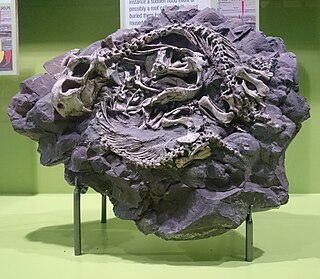
Dicynodontia is an extinct clade of anomodont therapsids. Dicynodonts were herbivorous animals with a pair of tusks, hence their name, which means 'two dog tooth'. Members of the group possessed a horny, typically toothless beak, unique amongst synapsids. Dicynodonts first appeared during the mid-Permian, and became dominant in the Late Permian, they were devastated by the end-Permian Extinction that wiped out most other therapsids, before rebounding during the Triassic, dying out towards the end of the period. They were the most successful and diverse of the non-mammalian therapsids, with over 70 genera known, varying from rat- to elephant-sized.
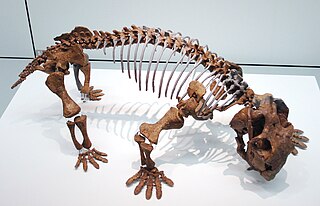
Anomodontia is an extinct group of non-mammalian therapsids from the Permian and Triassic periods. By far the most speciose group are the dicynodonts, a clade of beaked, tusked herbivores. Anomodonts were very diverse during the Middle Permian, including primitive forms like Anomocephalus and Patranomodon and groups like Venyukovioidea and Dromasauria. Dicynodonts became the most successful and abundant of all herbivores in the Late Permian, filling ecological niches ranging from large browsers down to small burrowers. Few dicynodont families survived the Permian–Triassic extinction event, but one lineage (Kannemeyeriiformes) evolved into large, stocky forms that became dominant terrestrial herbivores right until the Late Triassic, when changing conditions caused them to decline.

Caseasauria is one of the two main clades of early synapsids, the other being the Eupelycosauria. Caseasaurs are currently known only from the Late Carboniferous and the Permian, and include two superficially different families, the small insectivorous or carnivorous Eothyrididae, and the large, herbivorous Caseidae. These two groups share a number of specialised features associated with the morphology of the snout and external naris.
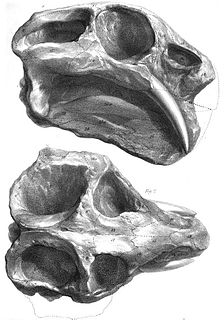
Dicynodon is a genus of dicynodont therapsid that flourished during the Upper Permian period. Like all dicynodonts, it was herbivorous. This animal was toothless, except for prominent tusks, hence the name. It probably cropped vegetation with a horny beak, much like a tortoise, while the tusks may have been used for digging up roots and tubers.
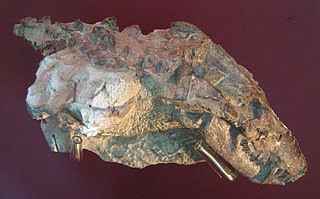
Thrinaxodontidae is an extinct family of cynodonts that includes the genera Thrinaxodon, Nanictosaurus, Nanocynodon, and Novocynodon, and possibly Bolotridon and Platycraniellus. All thrinaxodontids share a bony secondary palate. Thrinaxodontids are basal members of the cynodont clade Epicynodontia. Some studies consider the family a paraphyletic group, representing an evolutionary grade of basal epicynodonts rather than an actual clade.

Dinogorgon is a genus of gorgonopsid from the Late Permian of South Africa and Tanzania. The generic name Dinogorgon is derived from Greek, meaning "terrible gorgon", while its species name rubidgei is taken from the surname of renowned Karoo paleontologist, Professor Bruce Rubidge, who has contributed to much of the research conducted on therapsids of the Karoo Basin. The type species of the genus is D. rubidgei.

Aelurognathus is an extinct genus of gorgonopsian therapsids from the Permian of South Africa.
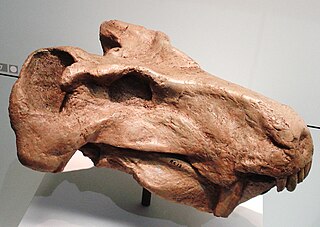
Rubidgea is a genus of gorgonopsid from the upper Permian of South Africa and Tanzania, containing the species Rubidgea atrox. The generic name Rubidgea is sometimes believed to be derived from the surname of renowned Karoo paleontologist, Professor Bruce Rubidge, who has contributed to much of the research conducted on therapsids of the Karoo Basin. However, this generic name was actually erected in honor of Rubidge's paternal grandfather, Sydney Rubidge, who was a renowned fossil hunter. Its species name atrox is derived from Latin, meaning “fierce, savage, terrible”. Rubidgea is part of the gorgonopsian subfamily Rubidgeinae, a derived group of large-bodied gorgonopsians restricted to the Late Permian (Lopingian). The subfamily Rubidgeinae first appeared in the Tropidostoma Assemblage Zone. They reached their highest diversity in the Cistecephalus and Daptocephalus assemblage zones of the Beaufort Group in South Africa.
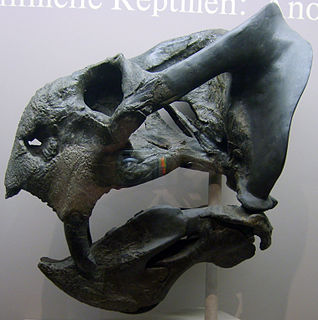
Daptocephalus is an extinct genus of non-mammalian synapsid anomodont dicynodont, it which was found in Late Permian strata, in a biozone known precisely for the presence of fossils of this dicynodont, the Daptocephalus Zone, in the Karoo Basin in South Africa. An additional species, D. huenei, is known from the Usili Formation in Tanzania and was formerly assigned to the genus Dicynodon before a study in 2019 recognised that the type specimen belonged to Daptocephalus.

Eriphostoma is an extinct genus of gorgonopsian therapsids known from the Middle Permian of Tapinocephalus Assemblage Zone, South Africa. It has one known species, Eriphostoma microdon, and was first named by Robert Broom in 1911. It is the oldest known gorgonopsian and among the smallest and most basal members of the clade.

Smilesaurus is an extinct genus of gorgonopsian known from Africa. It lived during the Late Permian. It contains the single species S. ferox.

Lystrosauridae is a family of dicynodont therapsids from the Permian and Triassic time periods. It includes two genera, Lystrosaurus and Kwazulusaurus. Kwazulusaurus includes a single species, K. shakai, from the Late Permian of South Africa and Lystrosaurus includes many species from the Late Permian and Early Triassic of South Africa, India, and Antarctica.

Dicynodontoidea is an infraorder of dicynodont therapsids that includes the famous dicynodont Dicynodon, Lystrosaurus and the Triassic Kannemeyeriiformes, as well as numerous other closely related species. The name was coined by American paleontologist Everett C. Olson in 1941 as an infraorder, despite using the typical "-oidea" suffix of superfamilies, and was later redefined under a phylogenetic context in 2009 by paleontologist Christian F. Kammerer.

Kannemeyeriiformes is a group of large-bodied Triassic dicynodonts. As a clade, Kannemeyeriiformes has been defined to include the species Kannemeyeria simocephalus and all dicynodonts more closely related to it than to the species Lystrosaurus murrayi.
Syops is an extinct genus of dicynodont therapsid. The type species S. vanhoepeni was first named in 1938 as Dicynodon vanhoepeni. Fossils of the genus have been found in the Cistecephalus Assemblage Zone in the Usili Formation of the Ruhuhu Basin, Tanzania and Madumabisa Mudstone, Zambia. Its phylogenetic placement is somewhat uncertain, with multiple different studies finding it as either a basal geikiid, rhachiocephalid a dicynodontoid more derived than the most basal genera but less derived than Lystrosauridae, or a lystrosaurid.

Emydopoidea is a group of Late Permian dicynodont therapsids. It includes the small-bodied Emydops, Myosaurus, and kingoriids, and the burrowing cistecephalids. Below is a cladogram from Kammerer et al. (2011) showing the phylogenetic relationships of emydopoids:
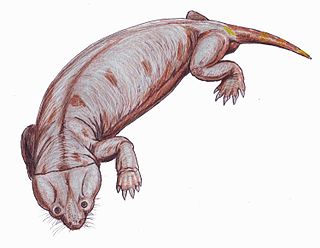
Cistecephalidae is an extinct family of dicynodont therapsids from the Late Permian of South Africa, India and Zambia. It includes the genera Cistecephalus, Cistecephaloides, and Kawingasaurus. Cistecephalids are thought to have had a fossorial or burrowing lifestyle, with adaptations such as broad skulls, strong forelimbs, and squat bodies. A similar group of dicynodonts called the pylaecephalids were also fossorial, although to a lesser extent than cistecephalids. Cistecephalids showed a high level of endemism, with each of the five known species unique to a single region.

Syodontinae is a group of dinocephalian therapsids. It is one of two subfamilies in the family Anteosauridae, the other being Anteosaurinae. They are known from the Middle Permian Period of what is now Russia and South Africa. One of the best known syodontines is Syodon from Russia. The South African form Australosyodon, is one of the earliest known Gondwanan anteosaurs.
Simorhinella is an extinct genus of therocephalian therapsids from the Late Permian of South Africa. It is known from a single species, Simorhinella baini, named by South African paleontologist Robert Broom in 1915. Broom named it on the basis of a single fossil collected by the British Museum of Natural History in 1878 that included the skull and jaws forward from the eye sockets. The skull is unusual in that it has an extremely short and deep snout, unlike the longer and lower snouts of most other therocephalians. Because of the skull's distinctiveness, the classification of Simorhinella within Therocephalia is uncertain. However, a 2014 study proposed that it was closely related to the basal therocephalian Lycosuchus, placing it in the family Lycosuchidae.
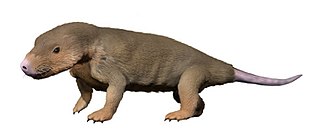
Charassognathidae is an extinct family of basal cynodonts known from the Late Permian of South Africa and Zambia. It was named in 2016 by the palaeontologist Christian F. Kammerer, who defined it as all taxa more closely related to Charassognathus gracilis than to Dvinia prima, Galesaurus planiceps or Procynosuchus delaharpeae. The family contains the genera Charassognathus, Abdalodon and Nshimbodon, with the latter two making up the subfamily Abdalodontinae.

















